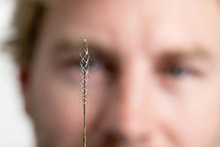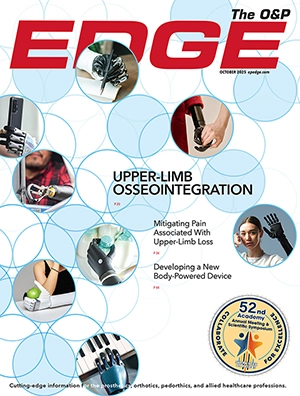
The device is implanted into a blood vessel next to the brain and can read electrical signals from the motor cortex.
Photograph courtesy of the University of Melbourne.
Researchers have developed what they say is the world’s first minimally invasive brain-machine interface (BMI) that, once implanted within a blood vessel in the brain, has been shown to allow users to control an exoskeleton or bionic limbs with the power of thought. The BMI, which is the size of a paperclip, consists of a stent-based electrode (stentrode) that is crafted from an alloy called nitinol. The results of the initial study, published online February 8 in Nature Biotechnology, show the device is capable of recording high-quality signals emitted from the brain’s motor cortex without the need for open brain surgery. The stentrode will be inserted into the blood vessel with a catheter fed up through the groin-the same approach that has been used for years for cardiology and removing stroke clots.
“Our vision, through this device, is to return function and mobility to patients with complete paralysis by recording brain activity and converting the acquired signals into electrical commands, which in turn would lead to movement of the limbs through a mobility assist device like an exoskeleton. In essence, this is a bionic spinal cord,” said Thomas Oxley, MD, PhD, principal author and neurologist at The Royal Melbourne Hospital, Parkville, Australia; and research fellow at The Florey Institute of Neuroscience and Mental Health (The Florey), Melbourne, Australia, and the University of Melbourne. Oxley is currently based at Mount Sinai Hospital, New York.
Co-principal investigator and biomedical engineer at the University of Melbourne, Nicholas Opie, PhD, said the concept was similar to an implantable cardiac pacemaker-electrical interaction with tissue using sensors inserted into a vein, but inside the brain. “Utilizing stent technology, our electrode array self-expands to stick to the inside wall of a vein, enabling us to record local brain activity,” said Opie. “By extracting the recorded neural signals, we can use these as commands to control wheelchairs, exoskeletons, prosthetic limbs, or computers.”
Clive May, PhD, neurophysiologist at The Florey, said the data from the preclinical study showed that the implantation of the device was safe for long-term use. “Through our preclinical study we were able to successfully record brain activity over many months,” said May. “The quality of recording improved as the device was incorporated into tissue.”
The stentrode will be implanted in the first in-human trial in 2017 at The Royal Melbourne Hospital; the first patients will most likely be young people who have suffered a traumatic spinal cord injury around six months to a year earlier, who are suitable for exoskeleton legs. The research team said it hopes to achieve direct brain control of an exoskeleton by the study cohort.
Editor’s note: This story was adapted from materials provided by the University of Melbourne.



